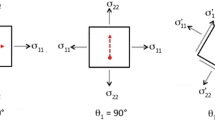Abstract
Electromagnetic acoustic resonance of 2.25 Cr–1Mo steel plates with (Fe, Cr)3O4 oxide layers of thickness from 0.03 mm to 0.18 mm were investigated. Due to the phase shift at the interface between the metal and the oxide layer, the resonance frequency, f n, was not proportional to resonance order, n, but n/f n varied depending both on the frequency and the oxide layer thickness. A model to derive the amount of the phase shift at the interface was developed, and a good agreement with experiments was found. It was shown that the oxide layer thickness, h, could be obtained as h = 0.33 × c oxide/f max, where c oxide is the shear wave velocity in the oxide layer and f max is the frequency at which n/f n had a maximum. The shear wave velocity in the oxide layer was determined as 3400 m/sec and the reflection coefficient at the interface as 0.09.
Similar content being viewed by others
Reference
D. L. Cartwright, Ultrasonic thickness measurement of weathering steel, Mater. Eval. 53(4) 452-456 (1995).
M. Hirao and H. Ogi, Electromagnetic acoustic resonance and material characterization, Ultrasonics 35, 413-420 (1997).
M. Hirao, H. Ogi and H. Fukuoka, Resonance EMAT system for acoustoelastic stress measurements in sheet metals, Rev. Sci. Instrum. 64, 3198-3205 (1993).
M. Hirao and H. Ogi, Electromagnetically excited acoustic resonance for evaluating attenuation coefficient and grain size in polycrystalline metals. Appl. Phys. Lett. 64(17), 2217-2219 (1994).
A. V. Clark and S. R. Schaps, Acoustoelastic determination of residual stress by measurements of resonance peaks and phase shifts. J. Nondest. Eval. 17(2), 89-102 (1998).
H. Nishida, H. Yamaguchi and M. Yoshida, Use of electromagnetic acoustic resonance method to detect micro-voids via evaluation of ultrasonic wave attenuation coefficient of SUS304 steel fabricated by hot isostatic press. JSME Int. J. 44, 8-16 (2001).
H. Ogi, G. Shimoike M. Hirao, K. Takashima and Y. Higo, Anisotropic elastic-stiffness coefficients of an amorphous Ni-P film. J. Appl. Phys. 91(8), 4857-4862 (2002).
Author information
Authors and Affiliations
Corresponding author
Rights and permissions
About this article
Cite this article
Yoshida, M., Asano, T. A New Method to Measure the Oxide Layer Thickness on Steels Using Electromagnetic Acoustic Resonance. Journal of Nondestructive Evaluation 22, 11–21 (2003). https://doi.org/10.1023/A:1025776030607
Issue Date:
DOI: https://doi.org/10.1023/A:1025776030607




